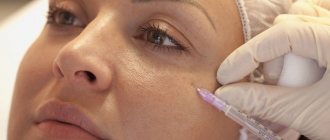Indications for eye surgery
Most people believe that ophthalmological surgery is safe, quick and comfortable for the patient. But this opinion is not always true.
With every ophthalmological intervention, there is a risk of developing pathology and vision deterioration. The intervention may be unsuccessful, and not everything always depends on the ophthalmologist performing the operation.
Before the intervention, the patient must carefully assess his condition. Review information on the selected intervention. Assess contraindications and possible side effects. A person must evaluate the possible consequences. Treatment does not always go smoothly and without consequences. Although in most cases this is true.
Most patients undergo surgery to improve vision for the following pathologies:
- myopia (nearsightedness);
- hypermetropia (farsightedness);
- cataract (clouding of the lens).
Ophthalmic surgery will allow a person to restore lost visual acuity. The person will again be able to engage in activities that require excellent vision (driving a car, riding a bicycle, and in some cases reading books).
If surgery is necessary for a child, parents should evaluate the pros and cons. The child cannot make decisions on his own. This means that his vision completely depends on the choice of his parents.
What is it and what changes does the correction bring?
There are three main types of blepharoplasty, which differ depending on the results.
Upper
Upper blepharoplasty is indicated for drooping eyelids . It allows you to eliminate sagging skin, makes it possible to open your eyes and change the shape of your eyes. This gives a pronounced rejuvenating effect. In this case, the incision is made along the natural crease of the eyelid.
After healing, the stitches are almost invisible and can be easily disguised with cosmetics.
We invite you to watch a video about upper blepharoplasty:
We talked in more detail about upper eyelid blepharoplasty here.
Lower
With this type, dissection is possible in two ways:
- along the eyelash line;
- by puncture through the mucous membrane.
In the latter case, surgery only helps to remove fat bags. The first option has a more extensive effect and makes it possible to eliminate excess skin and deep wrinkles.
We invite you to watch a video about lower blepharoplasty:
We talk about all the nuances and features of lower eyelid blepharoplasty in a special article.
Circular
With circumferential blepharoplasty, both the upper and lower eyelids are affected . It gives a complex effect:
- correction of drooping eyelids and drooping corners of the eyes;
- elimination of fat bags in the paraorbital area;
- correction of asymmetrical eye shape.
This type is considered preferable for comprehensive elimination of signs of aging. It can be supplemented with other techniques to improve results. The stitches after the operation are not visible at all.
Find more information about circumferential blepharoplasty here.
Scleroplasty
Does not restore vision completely, but blocks the continued decline in visual acuity. Prescribed mainly for myopia in people over 18 years of age. This is due to the fact that a child’s eye is susceptible to change (the shape of the eye and its components changes).
Therefore, if you “introduce” sclera-strengthening material into a child’s eye, then over time the material will stretch and can lead to worsening vision.
Scleroplasty is aimed at stabilizing vision. It is not a corrective intervention.
Lasts 20-30 minutes. And it consists of introducing sclero-strengthening material (patient tissue, synthetic polymers, silicone, etc.) into the eye. The sclera-strengthening material adheres to the outer membrane of the eye. The decrease in vision is blocked.
Scleroplasty is prescribed for progressive myopia. In the case where vision correction is prohibited for some reason.
It is not recommended to perform scleroplasty in the following cases:
- children's age (up to 5 years);
- psychosomatic disorders;
- the presence of viral or infectious diseases;
- dystrophy of the visual apparatus;
- allergy or hypersensitivity to sclera-reinforcing material;
- allergy to an anesthetic drug.
During pregnancy, this intervention is permitted. But it is still recommended to undergo scleroplasty before or after pregnancy.
After the operation, each patient faces a long rehabilitation period. Includes:
- It is not recommended for 1-2 weeks to read books, sit at the computer, watch TV, limit the use of the phone (you cannot strain your eyes);
- Do not visit the pool or play sports for 4-5 weeks;
- 2-3 weeks (determined individually) wear glasses with filters from ultraviolet rays (after the intervention there is an acute reaction to light);
- limit vigorous physical activity for 8-12 months.
It is recommended to follow all instructions from your doctor. Instill restorative antibacterial drops. Then the rehabilitation period will be favorable and will not suffer negative consequences.
The cost of scleroplasty starts from 3,000 thousand rubles per eye. The cost depends on the region of residence, the ophthalmology clinic and the qualifications of the specialist. It is important to carefully approach the choice of an ophthalmology clinic. The future state of vision may depend on this choice.
What types of surgery are there?
There are several types of canthoplasty. During the consultation, the surgeon will advise which correction method is best for you. The choice depends on the location of exposure: the corners of the eyes or the incision.
Lateral canthoplasty
This procedure is recommended for patients whose goal is to correct the outer corner of the eyes. The reasons for this deficiency may be age-related changes. During the operation, it is possible to remove skin folds and wrinkled mesh, due to which the facial expression becomes less dissatisfied and tired.
Medial canthoplasty
This type is most often used to correct deficiencies that affect the aesthetic appearance. The doctor adjusts the shape of the incision, working with the inner corner of the eyes. This type is considered the least traumatic and the most effective.
Canthopexy
Most patients use this term as a synonym for canthoplasty itself. However, there are differences. The purpose of this type of correction is only aesthetic, in contrast to plastic surgery, which can also be performed for medical reasons. This operation is performed by representatives of both sexes, the goal is to strengthen the eyelids, eliminate eversion and sagging. These factors are caused by age-related changes. The essence of the procedure is to surgically tighten the corners of the eyes. Canthopexy differs from canthoplasty by less surgical intervention.
Epicanthoplasty
This procedure is performed for aesthetic and medical reasons. The essence of the operation is to eliminate folds of skin that have formed in the inner corners of the eyes. They are called epicanthus, which was the name of the operation. The presence of such sweetness for representatives of the Asian and Mongoloid races is considered the norm, but for Europeans it often serves as a reason for correction. After the operation, the look becomes more open, the eyes look wider and larger.
Vitrectomy
Surgery to partially or completely remove the vitreous humor (the clear substance that fills the space between the retina and the lens). Performed by a highly qualified surgeon. Lasts 1.5-3 hours.
Indications:
- vitreous opacification;
- infectious or inflammatory diseases of the inner lining of the eye;
- retinal disinsertion;
- mechanical injuries resulting in dislocation of the lens;
- hemorrhage into the vitreous body.
The patient's vitreous body is removed and an artificial lens is placed in its place.
Not recommended in the following cases:
- pregnancy period;
- regular or periodic increase in intraocular pressure (glaucoma);
- high degrees of opacification of the lens and cornea.
With vitrectomy, vision is restored gradually. The period of restoration of vision acuity lasts 1-2 months.
If the operation did not go so smoothly or the patient did not follow the doctor’s recommendations, complications may arise:
- infectious diseases;
- retinal disinsertion;
- development of glaucoma (a group of diseases characterized by increased intraocular pressure);
- clouding of the cornea or lens.
The cost starts from 20 thousand rubles. The price depends on the region of residence and the clinic performing the intervention. Vitrectomy can reach a cost of 100 thousand per eye.
Preparing for eye enlargement surgery
First of all, you will need a consultation with a doctor, during which the patient expresses his wishes, and the specialist collects an anamnesis of his medical history/problem and life. The surgeon must tell you in detail about the technique of the operation, the possible risks, and demonstrate the results before and after using examples of work already performed.
The problem of the need to correct the entire face is discussed separately, since it is necessary for the cheekbones, nose and even forehead to be in harmony with the “new” eyes. It is quite possible that the doctor will give recommendations regarding a complex of plastic surgeries.
If no contraindications are identified at the initial consultation, the patient is sent for examination. Within its framework the following is carried out:
- urine collection for general analysis,
- blood collection for a comprehensive laboratory test (biochemical, general tests, HIV, syphilis, hepatitis, determination of the Rh factor, coagulogram),
- fluorography,
- ECG.
At the preparatory stage, you must undergo an examination and get advice from an ophthalmologist, therapist and endocrinologist.
Laser coagulation of the retina
A lens is placed on the patient's eye through which the laser is passed. Retinal tears are repaired using a laser. If the gap is not “soldered” in time, it will turn into retinal detachment. Detachment is much more difficult to treat. Therefore, it is important to undergo surgery on time - laser coagulation of the retina.
Corrects small retinal detachments (decided individually with each patient).
The intervention lasts 20 minutes. Before this, the patient is instilled with anesthetic drops.
Contraindications:
- clouding of the visual apparatus;
- vascular pathologies (including differences in hemorrhage);
- reduced visual acuity (with vision 0.1 it is not recommended);
- dystrophy of the organs of the visual apparatus.
A complication may occur - corneal edema. Causes temporary visual impairment. But if the instructions of the operating doctor are followed, the patient’s vision is restored.
The cost of laser coagulation of the retina is from 2 thousand rubles to 50 thousand. rubles
Foxy look: Kendall Jenner, Jennifer Lawrence and other stars who changed their eye shape
Comparing photographs of stars from different years, you can notice that their appearance changes subtly: girls who initially have good, but quite ordinary data, acquire gloss over the years and look much more impressive. You can attribute this to natural age-related changes in the face or makeup features, but many still tend to think that such metamorphoses do not occur by themselves.
In Hollywood, procedures are common that do not change the appearance radically, but quite significantly: for example, among them are an endoscopic forehead lift (even young girls do it), changing the bend of the eyebrows either with the help of Botox or through a microscopic incision in the eyebrows (thanks to the procedure, the outer corner slightly noticeably rises, and a characteristic “foxy” squint appears) and blepharoplasty, which removes excess skin of the upper eyelids, which makes the look seem heavy.
Which celebrities have taken advantage of the achievements of modern aesthetic medicine? Hollywood beauties usually do not talk about such interventions, but we invite you to look at their photos and decide for yourself whether they resorted to these procedures or simply became prettier over time.
Bella Hadid
Bella Hadid
Bella is perhaps the most popular model today. Not a single significant fashion show can do without it. But in her youth the girl did not look at all as impressive as she does now. It is no secret that the beauty changed the shape of her nose, but at the same time, as insiders say, she also changed the shape of her eyes. And indeed, her eyes look a little different now than they did as a teenager.
- The beauty of the stars Didn't expect it! 7 celebrities who have to wear wigs
- The beauty of the stars
6 stars who were considered strange - but their appearance helped them achieve success
Kendall Jenner
Kendall Jenner
The Kardashian-Jenner sisters are champions of changing their appearance in subtle but effective ways. The girls have become adept at using fillers competently. So, Kendall clearly turned to the same specialist as her older sisters Kim, Kourtney and Khloe. Judging by the photo, the top model slightly enlarged her lips, made the oval of her face clearer, and her eyes became more expressive. The plan to improve your appearance was one hundred percent successful, don’t you agree?
Ariana Grande
Ariana Grande
Looking at photographs of the singer, Internet users argue every now and then whether the girl resorted to the services of surgeons. Some are sure that her bright appearance is the merit of makeup artists who competently draw arrows on the eyelids, while others believe that Ariana made her rather large and round eyes almond-shaped with the help of a small lift. It is impossible to say for sure which side is true, because the singer herself did not confirm such rumors.
Jennifer Lawrence
Jennifer Lawrence
Oscar-winner Jennifer Lawrence has a naturally heavy upper eyelid: a fold of skin used to cover it almost completely. They say that the actress wanted to get rid of this feature and decided to undergo blepharoplasty. If there was any intervention, it was done very delicately. Lawrence's gaze actually became softer, and her movable eyelid opened a little.
Hailey Bieber
Hailey Bieber
Justin Bieber's wife has always been a spectacular girl. At the beginning of her modeling career, the blonde looked no less stunning than she does now. However, many are sure that before ascending to the starry Olympus, the beauty thoroughly worked on her appearance in a specialist’s office. Thus, according to plastic surgeon Dr. Yon, who commented on the changes in Baldwin-Bieber’s appearance for the Radar Online portal, Hailey, using injections, changed the curve of her eyebrows, making it clearer and more beautiful. In addition, the doctor believes that the model had surgery on her nose and injected filler into her chin and possibly into her cheekbones.
Photo source: Legion-media.ru
Strabismus Correction
Surgery to correct strabismus usually occurs in childhood. Adults seek such intervention most often in the case of acquired strabismus (squint).
Indications:
- strabismus;
- paralysis of the eye muscles.
The intervention allows for a cosmetic effect and restores the patient’s vision. But vision does not always return in full. After the operation, only half of the vision returns.
Ophthalmologists recommend resorting to this operation only if conservative (non-surgical) methods do not help. This manipulation is an intervention of particular complexity.
The cost is within 20 thousand rubles.
What is canthoplasty and canthopexy?
Canthoplasty is a plastic surgery that is aimed at changing the size of the palpebral fissure by correcting the outer and inner corners of the eye, and canthopexy is a surgical technique for correcting signs of sagging skin in the lower eyelid and lifting the outer corners of the eyes.
Canthoplasty
During canthoplasty, the surgeon makes an S-shaped incision on the edge of the eyelid (near the outer corner of the eye), due to which the eye acquires a peculiar curvature and round shape, and cuts the skin at the junction of the lower and upper eyelid, making the eye longer (experts do not recommend make an incision larger than 5 mm, because the lashless edge of an enlarged eyelid looks unnatural). If necessary, the doctor, through an incision, excises excess skin in the lower eyelid area and moves excess periorbital fat, which makes it possible to hide the signs of aging in the periorbital area and make the look more open.
Canthopexy
Canthopexy is a less traumatic technique because during it, the surgeon, using several sutures, tightens the canthal tendon, which fixes the corner of the eye, as a result of which the corner of the eyes is raised and the lower eyelid is tightened.
Surgery to increase the size of the eyes can eliminate swelling of the eyelids, give the palpebral fissure a more rounded shape, make the gaze more open and expressive, and eliminate signs of aging in the periorbital area of the face.
The main indication for plastic surgery is considered to be a person’s desire to change the shape of the eye (the patient’s age should not be less than 18 years), but there are a number of other medical indications for canthoplasty and canthopexy, which include:
- the effect of bulging eyes (a consequence of myopia);
- inversion of the lower eyelid (side effect after lower eyelid blepharoplasty);
- narrowing of the palpebral fissure (blepharophimosis);
- drooping of the outer corner of the eye due to weakening of tendons or muscles;
- correction of congenital ocular pathologies (incomplete cleft or partial fusion of the palpebral fissure).
The operation takes place under general anesthesia and lasts on average 1-1.5 hours.
Crosslinking
The operation is performed on the cornea (the front convex part of the eyeball). A small thin layer of the cornea is cut away. The corneal layer is carefully strengthened. A protective lens is placed on top. Crosslinking is prescribed in the following cases:
- corneal dystrophy;
- keratoconus;
- keratomalacia;
- “burnout” of parts of the cornea.
Contraindications:
- age up to 15 years;
- pregnancy period;
- thin corneal layer;
- low visual acuity.
Crosslinking takes no more than 1 hour. The patient is in the hospital for 2-3 days. The operation is performed under local anesthesia. The result of the intervention lasts for 8-10 years.
The cost of crosslinking starts from 20 thousand rubles.
What do the eyes look like after surgery?
After surgery, it will take time for the stitches to heal and for swelling and bruising to disappear. Typically the rehabilitation period takes 5-12 days. To speed it up, you need to follow all the specialist’s recommendations.
Straightaway
Immediately after the intervention, the patient may feel pain and dry eyes, swelling and cyanosis will be very noticeable, and stitches will be visible. Over time, the symptoms disappear.
In the first days
Unpleasant symptoms usually bother patients during the first few days after surgery. They are as follows:
- swelling of the eyes and bluish skin;
- pain;
- feeling of “heavy eyelids”;
- feeling of dryness of the eyeball.
Some symptoms can be relieved with medication, while others you just need to wait it out.
How long does swelling last?
Usually the swelling goes away completely within 7-10 days . After 2-3 weeks, there are no traces of blue skin left. Scars usually take about a month to smooth out. But if they are located in the outer part of the eye, they take longer to heal.
The duration of the rehabilitation period depends on the patient’s age, skin type and structural features of the tissues in the eye area. If a patient's sutures heal abnormally slowly, revision of the scars may be necessary to prevent the proliferation of connective tissue.
Glaucoma treatment
Glaucoma is a group of diseases characterized by periodic or constant increases in intraocular pressure. This surgical intervention is prescribed if the patient does not respond to conservative methods. The operation can be performed at the request of the patient. A person gets tired of constantly instilling drops and taking pills.
Surgery to correct glaucoma is temporary (most often). Gradually, increased intraocular pressure returns to the patient.
During the rehabilitation period, a person must follow all instructions and advice of the attending physician. Then the effect of the operation will last longer and complications will be avoided.
The main complication is the appearance of infectious and inflammatory diseases.
In general, surgery to treat glaucoma is considered safe. In most cases it is successful.
The cost of laser intervention is from 8 thousand rubles. Surgical intervention – from 20 thousand rubles.
The essence of the operation
It is impossible to literally increase the size of the eyes surgically, but it is possible to make them more expressive and visually larger. And there are several ways to do this:
- removal of a fragment of skin from the upper eyelid,
- lifting the ciliary edge,
- removal of the fold above the inner corner of the eye (epicanthoplasty),
- correction of eye shape (canthoplasty).
Plastic surgeries to change the shape of the eyes are divided into two large groups – blepharoplasty and canthoplasty. In the first case, we are talking about manipulations on the upper, overhanging eyelid, in the second - about correction of the lower eyelid in the area of the inner corner.
We recommend reading the article about canthoplasty before and after. From it you will learn about indications and contraindications for eye canthoplasty, types and techniques for performing this operation, cost, as well as the results before and after canthoplasty. And here is more information about the operation to change eye color.
Cataract removal
Cataract is clouding of the lens of the eye. Surgical intervention is performed when conservative treatment methods do not help or in case of severe degrees of disease development. The damaged lens is removed using a laser or ultrasound.
A new artificial one is placed in its place. The operation lasts 15-20 minutes.
Contraindications:
- period of pregnancy and lactation;
- the presence of infectious ophthalmological diseases;
- inflammation;
- psychological disorders;
- heart failure;
- age under 18 years (contraindications are determined individually, based on the individual characteristics of the patient).
It is important to observe a rehabilitation period of 1-2 months. Do not perform heavy physical activity, do not go to the pool, stop driving (1-2 weeks after surgery). After replacing the lens, you should not rub your eyes.
Within 1-2 months, the lens should “take root” in the patient’s body. A person can again resume his usual way of life.
Cost – from 20 thousand rubles.
Rehabilitation period
Many patients are embarrassed by the appearance of bruises and swelling in the eye area after canthoplasty. Don't worry, this is a completely normal phenomenon after surgery. It will take at least a week for the effects to subside. To reduce discomfort, the doctor may recommend analgesics and cold compresses.
Due to the fact that the incision was made in a natural fold, the seams will be almost invisible. For their speedy healing, treatment with an antiseptic solution is necessary. A week after the operation, only a thin red line will be noticeable, and after a couple of months it will disappear.
After laser canthoplasty, rehabilitation lasts about 10 days, surgically - up to two weeks. Full recovery lasts up to a month. After about two weeks, your face will look fresher, more rested, your skin will glow with youth, and the bags under your eyes will disappear.
Laser vision correction
Laser correction is the most popular operation. Carried out when:
- myopia (myopia);
- hypermetropia (farsightedness)
- astigmatism.
Lasts 20-30 minutes using anesthetic drops. On the day of laser correction, the patient goes home. 1-2 days after the correction, the person will experience discomfort (acute reaction to light, tearfulness, pain). But gradually the discomfort goes away.
Laser correction is contraindicated in the following cases:
- age up to 18 years (determined individually based on the patient’s characteristics);
- infectious and inflammatory diseases;
- progressive state of myopia (hypermetropia, astigmatism).
In most cases it is successful. The patient's vision is completely restored.
The cost of laser correction starts from 20 thousand rubles.











